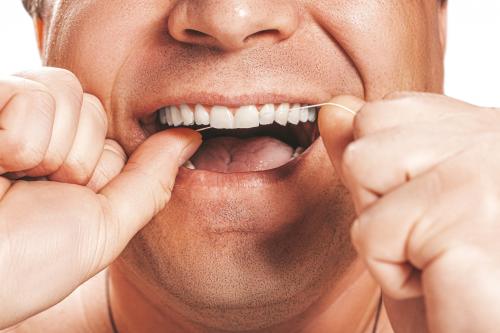The Importance Of Flossing To Maintain Good Oral Health

Good oral hygiene is crucial for overall health, and
flossing is an essential component of this. While brushing is important, it
only cleans the surface of teeth, leaving spaces between teeth and around gums
untouched.
Here are some reasons why regular flossing is essential for
maintaining good oral health.
Flossing Prevents Gum Disease
When food particles and plaque accumulate between teeth, they
can irritate gums, causing inflammation and leading to gingivitis. If left
untreated, gingivitis
can progress to periodontitis, a more severe form of gum disease that can
lead to tooth loss.
Flossing regularly helps remove food particles and plaque
from between teeth and gums, reducing the risk of gum disease.
Flossing Prevents Cavities
When plaque accumulates between teeth, it produces acid that
can erode tooth enamel and lead to cavities. Flossing removes plaque and
bacteria from areas that are difficult to reach with a toothbrush, reducing the
risk of tooth decay and cavities.
Flossing Freshens Breath
Bad breath, or halitosis, can be caused by food particles
and bacteria that accumulate between teeth and on the tongue. Flossing helps
remove these particles, thereby reducing the risk of bad breath and promoting
fresh breath.
Flossing Improves Overall Health
There is evidence
to suggest that oral health is linked to overall health. Poor oral hygiene
has been linked to an increased risk of heart disease, diabetes, and other
health conditions.
Flossing helps reduce the amount of bacteria in the mouth,
reducing the risk of these health conditions.
Flossing Helps You Save Money
Preventing dental problems is not only good for your health,
but it can also save you money in the long run. Flossing regularly can help
prevent gum disease and cavities, which can lead to costly dental procedures
such as fillings, root canals, and extractions.
How To Floss Properly
Flossing may seem like a simple task, but it is important to
do it properly to ensure it is effective. Here are some tips for proper
flossing technique:
1. Use a long piece of floss, around 18 inches. Wrap most of
the floss around your middle fingers and hold a small section with your thumb
and forefinger.
2. Gently slide the floss between your teeth, being careful
not to snap it down on your gums. Use a gentle back-and-forth motion to remove
plaque and debris.
3. When you reach the gumline, curve the floss around the
base of the tooth and gently slide it under the gumline.
4. Use a clean section of floss for each tooth, and don't
forget to floss behind your back teeth.
5. Rinse your mouth with water after flossing to remove any
remaining particles.
Boss It By Flossing
Flossing is an essential part of maintaining good oral
hygiene and preventing dental problems. By removing food particles and plaque
from between teeth and gums, flossing helps prevent gum disease, cavities, and
bad breath. It also promotes overall health and can save you money on costly
dental procedures.
Remember to floss at least once a day, using proper
technique, to keep your teeth and gums healthy!









Comments